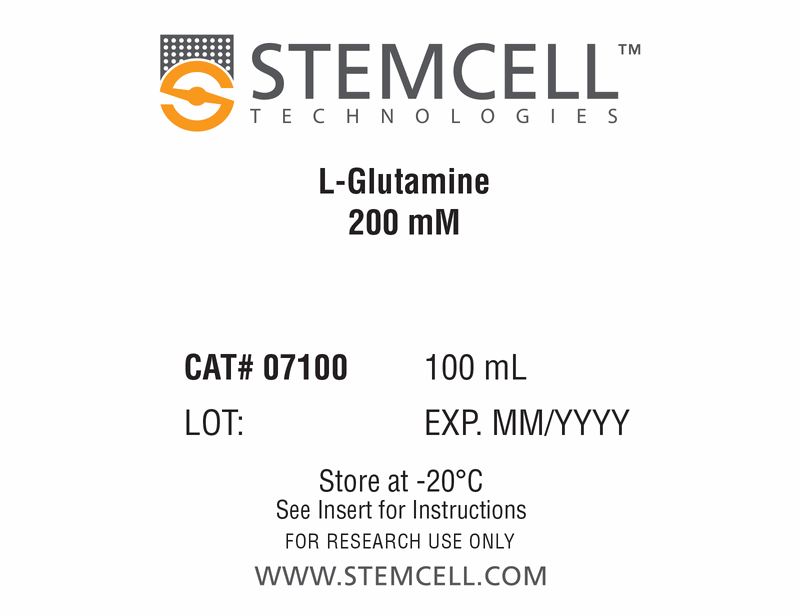L-Glutamine
Cell culture supplement
概要
L-Glutamine (200 mM) is recommended for use as a cell culture supplement and is required for the preparation of MesenCult™-ACF Plus Medium (Catalog #05445).
Subtype
Supplements
Cell Type
Mesenchymal Stem and Progenitor Cells, Neurons, Other
Species
Human, Mouse, Rat, Non-Human Primate, Other
Application
Cell Culture
技术资料
| Document Type | 产品名称 | Catalog # | Lot # | 语言 |
|---|---|---|---|---|
| Product Information Sheet | L-Glutamine | 07100 | All | English |
| Safety Data Sheet | L-Glutamine | 07100 | All | English |
数据及文献
Publications (2)
Journal of controlled release : official journal of the Controlled Release Society 2011 MAR
Development of a liposomal nanoparticle formulation of 5-fluorouracil for parenteral administration: formulation design, pharmacokinetics and efficacy.
Abstract
Abstract
5-Fluorouracil (5-FU) is a small, very membrane permeable drug that is poorly retained within the aqueous compartment of liposomal nanoparticles (LNP). To address this problem a novel method relying on formation of a ternary complex comprising copper, low molecular weight polyethylenimine (PEI) and 5-FU has been developed. More specifically, in the presence of entrapped copper and PEI, externally added 5-FU can be efficiently encapsulated (textgreater95%) in DSPC/Chol (1,2-Distearoyl-sn-Glycero-3-Phosphocholine/cholesterol; 55:45 mol%) liposomes (130-170 nm) to achieve drug-to-lipid ratios of 0.1 (mol:mol). Drug release studies completed using this LNP formulation of 5-FU demonstrated significant improvements in drug retention in vitro and in vivo. Plasma concentrations of 5-FU were 7- to 23-fold higher when the drug was administered intravenously to mice as the LNP 5-FU formulation compared to free 5-FU. Further, the therapeutic effects of the LNP 5-FU formulation, as determined in a HT-29 subcutaneous colorectal cancer model where treatment was given QDx5, was greater than that which could be achieved with free 5-FU when compared at equivalent doses. This is the first time an active loading method has been described for 5-FU. The use of ternary metal complexation strategy to encapsulate therapeutic agents may define a unique platform for preparation of LNP drug formulations.
Journal of immunology (Baltimore, Md. : 1950) 2006 JUL
A role for DNA hypomethylation and histone acetylation in maintaining allele-specific expression of mouse NKG2A in developing and mature NK cells.
Abstract
Abstract
The repertoire of receptors that is expressed by NK cells is critical for their ability to kill virally infected or transformed cells. However, the molecular mechanisms that determine whether and when NK receptor genes are transcribed during hemopoiesis remain unclear. In this study, we show that hypomethylation of a CpG-rich region in the mouse NKG2A gene is associated with transcription of NKG2A in ex vivo NK cells and NK cell lines. This observation was extended to various developmental stages of NK cells sorted from bone marrow, in which we demonstrate that the CpGs are methylated in the NKG2A-negative stages (hemopoietic stem cells, NK progenitors, and NKG2A-negative NK cells), and hypomethylated specifically in the NKG2A-positive NK cells. Furthermore, we provide evidence that DNA methylation is important in maintaining the allele-specific expression of NKG2A. Finally, we show that acetylated histones are associated with the CpG-rich region in NKG2A positive, but not negative, cell lines, and that treatment with the histone deacetylase inhibitor trichostatin A alone is sufficient to induce NKG2A expression. Treatment with the methyltransferase inhibitor 5-azacytidine only is insufficient to induce transcription, but cotreatment with both drugs resulted in a significantly greater induction, suggesting a cooperative role for DNA methylation and histone acetylation status in regulating gene expression. These results enhance our understanding of the formation and maintenance of NK receptor repertoires in developing and mature NK cells.


